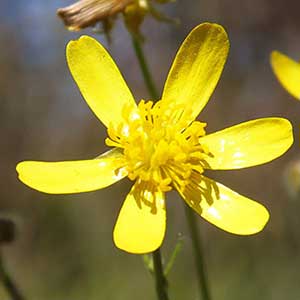|
low buttercup, low spearwort, weak buttercup
|
southern Oregon buttercup
|
not thickened basally, glabrous. |
never tuberous. |
erect or ascending, rooting at most proximal nodes, glabrous. |
erect or ascending, never rooting nodally, crisped-pilose, base not bulbous. |
|
blades broadly rhombic to semicircular in outline, 3-parted, 2.8-4.3 × 3-5.5 cm, segments 3-lobed, ultimate segments lanceolate, margins entire or toothed, apex narrowly acute or acuminate. |
ovate or lanceolate, 1.2-4.2 × 0.5-1.2 cm, base acute to truncate, margins entire or denticulate, apex acuminate to rounded. |
|
bracts linear to lanceolate or oblanceolate. |
|
receptacle glabrous; sepals 4-5, spreading or reflexed from base, 1.5-3 × 1-1.5 mm, glabrous or sparsely hirsute; petals 1-3, 1.5-2 × 0.5-1 mm; nectary scales glabrous. |
receptacle glabrous; sepals reflexed 1 mm above base, 4-6 × 1.5-3 mm, densely pilose; petals 5, abaxially red, adaxially yellow, 10-12 × 4-6 mm. |
hemispheric to cylindric, 2-8 × 2-3 mm; achenes 1-1.2 × 0.6-0.8 mm, ± tuberculate, glabrous; beak absent or nearly so, to 0.1 mm. |
hemispheric, 4-7 × 7-10 mm; achenes 3.4-4.2 × 2.8-3.2 mm, sometimes basally pilose, margin forming narrow rib 0.1-0.2 mm wide; beak persistent, lance-subulate, straight or somewhat curved distally, 1.6-2.6 mm. |
|
|
|
|
| Flowering spring (Apr–Jun). |
Flowering spring (May). |
| Ditches, ponds, and swamps |
Grassy hillsides |
| 0-300 m (0-1000 ft) |
500 m (1600 ft) |
|
AL; AR; CA; DC; DE; FL; GA; IL; IN; KY; LA; MD; MO; MS; NC; NJ; NY; OH; OK; PA; SC; TN; TX; VA; WV
|
OR |
In most specimens of Ranunculus pusillus, the heads of achenes are hemispheric to short-ovate and only 2-3 mm. Occasional plants with cylindric heads of achenes 4-6 mm from the Gulf Coast states have been called R. pusillus var. angustifolius. (Discussion copyrighted by Flora of North America; reprinted with permission.) |
Of conservation concern. Ranunculus austro-oreganus is doubtfully distinct from R. occidentalis var. howellii. L. D. Benson (1954) described the stem as bulbous-based and similar to that of R. bulbosus, but a differentiated base is not evident in material I have seen (some of which was cited by Benson). (Discussion copyrighted by Flora of North America; reprinted with permission.) |
| FNA vol. 3. |
FNA vol. 3. |
| Ranunculaceae > Ranunculus > subg. Ranunculus > sect. Flammula |
Ranunculaceae > Ranunculus > subg. Ranunculus > sect. Ranunculus |
R. abortivus, R. acriformis, R. acris, R. adoneus, R. alismifolius, R. allegheniensis, R. allenii, R. ambigens, R. andersonii, R. aquatilis, R. arizonicus, R. arvensis, R. auricomus, R. austro-oreganus, R. bonariensis, R. bulbosus, R. californicus, R. canus, R. cardiophyllus, R. cooleyae, R. cymbalaria, R. eschscholtzii, R. fascicularis, R. fasciculatus, R. ficaria, R. flabellaris, R. flammula, R. gelidus, R. glaberrimus, R. glacialis, R. gmelinii, R. gormanii, R. harveyi, R. hebecarpus, R. hederaceus, R. hispidus, R. hydrocharoides, R. hyperboreus, R. hystriculus, R. inamoenus, R. jovis, R. kamtschaticus, R. lapponicus, R. laxicaulis, R. lobbii, R. macauleyi, R. macounii, R. macranthus, R. marginatus, R. micranthus, R. muricatus, R. nivalis, R. occidentalis, R. oresterus, R. orthorhynchus, R. pacificus, R. pallasii, R. parviflorus, R. pedatifidus, R. pensylvanicus, R. platensis, R. populago, R. pygmaeus, R. ranunculinus, R. recurvatus, R. repens, R. rhomboideus, R. sabinei, R. sardous, R. sceleratus, R. sulphureus, R. testiculatus, R. trilobus, R. triternatus, R. turneri, R. uncinatus |
R. abortivus, R. acriformis, R. acris, R. adoneus, R. alismifolius, R. allegheniensis, R. allenii, R. ambigens, R. andersonii, R. aquatilis, R. arizonicus, R. arvensis, R. auricomus, R. bonariensis, R. bulbosus, R. californicus, R. canus, R. cardiophyllus, R. cooleyae, R. cymbalaria, R. eschscholtzii, R. fascicularis, R. fasciculatus, R. ficaria, R. flabellaris, R. flammula, R. gelidus, R. glaberrimus, R. glacialis, R. gmelinii, R. gormanii, R. harveyi, R. hebecarpus, R. hederaceus, R. hispidus, R. hydrocharoides, R. hyperboreus, R. hystriculus, R. inamoenus, R. jovis, R. kamtschaticus, R. lapponicus, R. laxicaulis, R. lobbii, R. macauleyi, R. macounii, R. macranthus, R. marginatus, R. micranthus, R. muricatus, R. nivalis, R. occidentalis, R. oresterus, R. orthorhynchus, R. pacificus, R. pallasii, R. parviflorus, R. pedatifidus, R. pensylvanicus, R. platensis, R. populago, R. pusillus, R. pygmaeus, R. ranunculinus, R. recurvatus, R. repens, R. rhomboideus, R. sabinei, R. sardous, R. sceleratus, R. sulphureus, R. testiculatus, R. trilobus, R. triternatus, R. turneri, R. uncinatus |
| R. oblongifolius, R. pusillus var. angustifolius, R. tener |
|
| Poiret: in J. Lamarck et al., Encycl. 6: 99. (1804) |
L. D. Benson: Amer. Midl. Naturalist 52: 341. (1954) |
| |
OR
Flora NW,
PNW Herbaria
WildflowerSearch
iNaturalist (observations)


